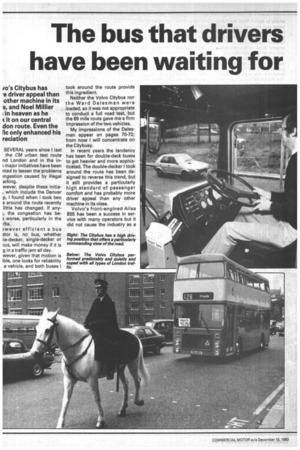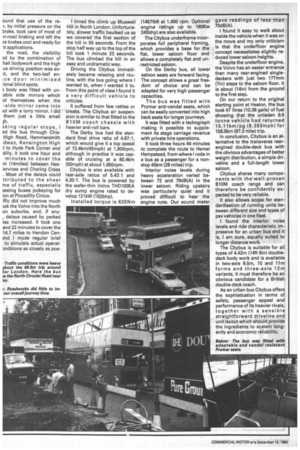The bus that drivers have been waiting for
Page 28

Page 29

Page 30

If you've noticed an error in this article please click here to report it so we can fix it.
ro's Citybus has .e driver appeal than other machine in its s, and Noel Millier I in heaven as he ( it on our central don route. Even the fie only enhanced his reciation SEVERAL years since I last the CM urban test route nd London and in the inmajor initiatives have been nted to lessen the problems )ngestion caused by illegal arking.
wever, despite these initia, which include the Denver p, I found when I took two s around the route recently little has changed. If any1, the congestion has beworse, particularly in the rbs.
)wever efficient a bus ator is, no bus, whether Ile-decker, single-decker or aus, will make money if it is g in a traffic jam all day.
wever, given that motion is ible, one looks for reliability a vehicle, and both, buses I took around the route provide this ingredient.
Neither the Volvo Citybus nor the Ward Dalesman were loaded, so it was not appropriate to conduct a full road test, but the 69 mile route gave me a firm impression of the two vehicles.
My impressions of the Dalesman appear on pages 70-72; from now I will concentrate on the Citybusy.
In recent years the tendency has been for double-deck buses to get heavier and more sophisticated. The double-decker I took around the route has been designed to reverse this trend, but it still provides a particularly high standard of passenger comfort and has probably more driver appeal than any other machine in its class.
Volvo's front-engined Ailsa B55 has been a success in service with many operators but it did not cause the industry as a whole to switch from the transverse rear-engined bus in great numbers. Now Volvo has put the engine between the axles and retained the advantages of the original Arise while overcoming virtually all its disadvantages.
The result, as I discovered, is a real driver's bus, which has the potential to consummate the revolution that the B55 initiated. The bus I tried has already been in service for a number of months in Derby with the local municipal undertaking. It is fitted with a Marshall 78-seat body built to Derby specifications.
The bus was a standard 9.5m long vehicle and had an optional 7F HP 500 fully automatic transmission with built-in retarder.
Citybus is also available with SCG five-speed pneumocyclic gearbox with CAV 511 fully automatic control or the Voith D851 fully automatic unit.
As Derby is relatively flat, the bus was rated and geared to meet this terrain and could have been a great deal livelier if required. Even so, it was no sluggard.
My first Impression was of the high and comfortable driving position, which not only offers a commanding view of the road but could welt serve to give the driver a psychological advantage when dealing with awkward passengers.
The Citybus is also fitted with the standard comprehensive Volvo instrument panel which includes a large range of warning lights and-instruments as well as a tachometer.
While the tachometer is not particularly useful with the fully automatic transmission, I agree with keeping drivers in touch with what is happening in the engineering department of their vehicles, and I feel that operators that reject such comprehensive instrumentation could be accused of undervaluing both man and machine.
Driving the bus is simplicity itself. Gear selection is done by pushing buttons. The ZF has hold buttons for intermediate gears but Derby did not have these connected as selecting D for drive was adequate for the local terrain, and indeed also proved adequate for our London test run.
Fuel was topped up at the Heston service area on the M4 before I set off around the route. The ride and handling o decker were particularly thanks partly to the air su sion and I found the ste second to none.
The large 50 Ommll 9 steering wheel, which is in to 22 degrees, was comfo, and the power-assisted st both light and positive.
Although the bus was sj cally prepared for operati Derby, it proved well suit the cut and thrust of Lc driving. The gear change a by the ZF HP 500 was sr and predictable and the loi retarder was capable of t the vehicle right down to a plete halt.
I found the ZF transmi similar in its change charac tics to the Voith D851 altho has the advantage of an tional gear and is signifir quieter in operation. ound that use of the rer, by initial pressure on the brake, took care of most of n-road braking and left the ce brakes cool and ready for it applications.
the road, the visibility ?cl by the combination of hall bodywork and the high us driving position was exit, and the two-leaf enIce door minimised lanai blind spots.
3 body was fitted with un:able side mirrors which )d themselves when the -side mirror came into ict with a lorry mirror. I did them just a little small 3h.
]king regular stops, I ad the bus through ChisHigh Road, Hammersmith dway, Kensington High t to Hyde Park Corner and dilly. It took one hour and minutes to cover the m (14miles) between Hes;ervices and Charing Cross . Most of the delays could ttributed to the sheer me of traffic, especially seeing buses jockeying for ion at Piccadilly Circus.
ffic did not improve much )ok the Volvo into the North on suburbs, and, if any, delays caused by parked les increased. It took one and 22 minutes to cover the 14.7 miles to Hendon Cenmd I made regular brief to simulate actual operatDnditions as closely as pas
I timed the climb up Muswell Hill in North London. Unfortunately, slower traffic baulked us as we covered the first section of the hill in 55 seconds. From the stop half way up to the top of the hill took 1 minute 23 seconds. The bus climbed the hill in an easy and undramatic way.
Driving the Citybus immediately became relaxing and routine, with the bus going where I wanted to, when I wanted it to. From this point of view I found it a very difficult vehicle to criticise.
It suffered from few rattles or creaks. The Citybus air suspension is similar to that fitted to the B1 OM coach chassis with heavier anti-roll bars.
The Derby bus had the standard final drive ratio of 4.87:1, which would give it a top speed of 72.4km(45mph) at 1,800rpm, although in practice it was capable of cruising at a 80.4km (50mph) at about 1,950rpm.
Citybus is also available with rear-axle ratios of 5.43:1 and 4.30:1. The bus is powered by the wafer-thin Volvo THD100EA dry sump engine rated to develop 121kW(162bhp).
Installed torque is 620Nm (1457Ibft at 1,400 rpm. Optional engine ratings up to 180Kw 245bhp) are also available.
The Citybus underframe incorporates full peripheral framing, which provides a base for the flat, lower saloon floor and allows a completely flat and unrestricted saloon.
On the Derby bus, all lower saloon seats are forward facing. The concept allows a great freedom of choice and can be adapted for very high passenger capacities.
The bus was fitted with Promar anti-vandal seats, which can be easily converted into high back seats for longer journeys.
It was fitted with a tachograph making it possible to supplement its stage carriage revenue with private hire operations.
It took three hours 44 minutes to complete the route to Hemel Hempstead, from where I rode in a bus as a passenger for a nonstop 45km (28 miles) trip.
Interior noise levels during heavy acceleration varied between 72 and 78dB(A) in the lower saloon. Riding upstairs was particularly quiet and it proved difficult to hear the engine note. Our sound meter gave readings of less than 70dB(A).
I found it easy to walk about inside the vehicle when it was on the move and my only criticism is that the underfloor engine concept necessitates slightly reduced lower saloon heights.
Despite the underfloor engine, the Volvo has an easier entrance than many rear-engined singledeckers with just two 177rrim (7n) steps to the saloon floor. It is about (14in) from the ground to the first step.
On our return to the original starting point at Heston, the bus took 47 litres (10.38 galls) of fuel showing that the unladen 9.5 tonne vehicle had returned 15.11km/pg (9.393mph) for 156.5km (97.3 mile) trip.
In conclusion, Citybus is an alternative to the transverse rearengined double-deck bus with the obvious advantages of better weight distribution, a simple driveline and a full-length lower saloon.
Citybus shares many components with the'well-proven B1OM coach range and can therefore be confidently expected to be very reliable.
It also allows scope for standardisation of running units between different size and types of psv vehicles in one fleet.
I found the interior noise levels and ride characteristic impressive for an urban bus and it is, I am sure, equally suited to longer distance work.
The Citybus is suitable for all types of 4.42m (14ft Sin) doubledeck body work and is available in two-axle 9.5m, 10 and 11ni forms and three-axle 12m variants. It must therefore be an obvious candidate for a British double-deck coach.
As an urban bus Citybus offers the sophistication in terms of safety, passenger appeal and performance of its heavier rivals, together with a sensible straightforward driveline and unit layout which should provide the ingredients to sustain longevity and economic reliability.












































































































